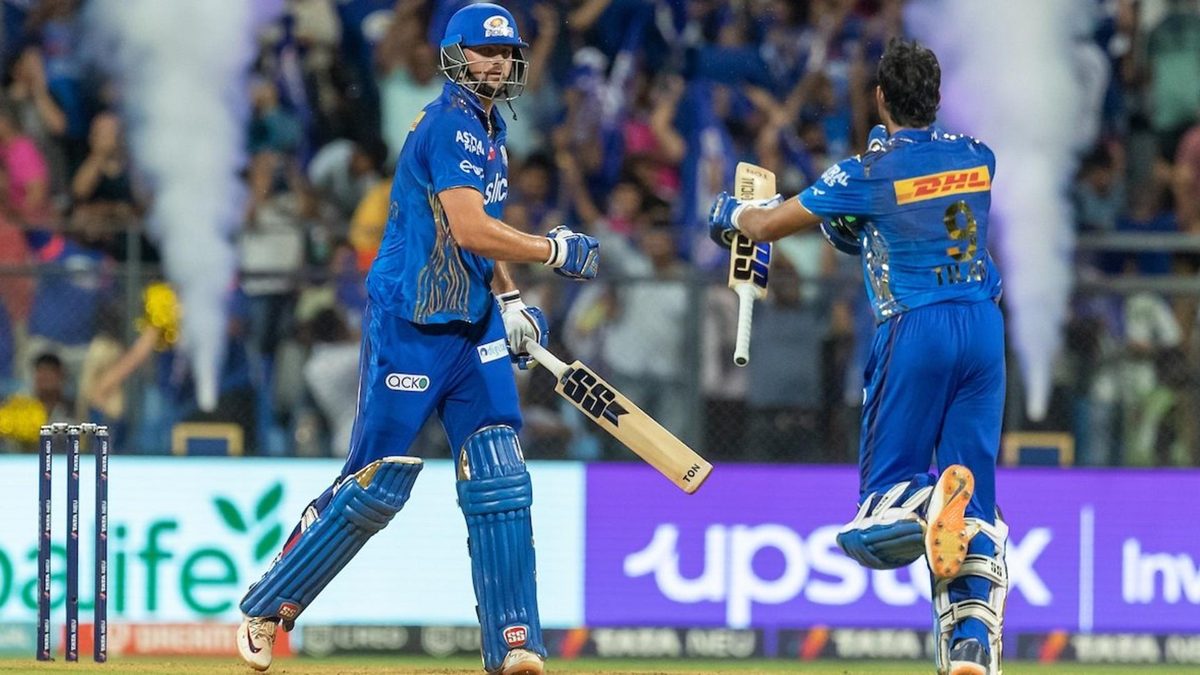
Sanju Samson entrusted Jason Holder to defend 17 runs from the final over at the Wankhede Stadium, but Tim David ended these aspirations in three hits.
Rajasthan Royals had probably felt good about their total of 212-7, for never had a target as big been successfully chased in an IPL match at the Wankhede. Yet Mumbai began well, and after 10 overs, they needed 115 with eight wickets in hand.
At this point, R Ashwin (4-0-27-2) took out Cam Green, and conceded three runs in his final over. That brought the left-handed Tilak Varma to the crease, but Samson decided to risk leg-spinner Yuzvendra Chahal nonetheless, and it paid off. The three-run over left Mumbai to chase 109 in 48 balls.
There was some cushion for Kuldeep Sen, Rajasthan’s Impact Player, to bowl his first over of the match and third of the season. He conceded a solitary run off his last three balls, but the early assault by Suryakumar Yadav meant that he went for 20.
Mumbai needed 89 in seven, and at this stage Chahal went for 17. Tilak Varma reverse-swept him for four and lofted him over long-off for six, demonstrating his obvious comfort at taking on the ball that came into him.
Samson still had two overs from Trent Boult and one from Sandeep Sharma up his sleeve, but he had to find other bowlers for the other three overs. He chose Jason Holder ahead of Sen. Boult took out Suryakumar, and with Tilak Varma still at the crease, Samson backed Holder again.
Only three overs remained, and with 43 to defend, Samson decided to play both his cards. With Boult and Sandeep up his sleeve, he used both upfront. Rajasthan neither got a wicket, nor were they able to cut down the runs: Boult went for 11 and Sandeep 15.
With 14.33 an over to defend, Rajasthan’s primary death bowlers, thus, conceded 26 in two overs – slightly, but not sufficiently, less than the asking rate.
They now had to defend 17. On strike was David, a man who hits a six every 10 balls and a four every nine, the second-quickest scorer in the history of the format with a 3,000-run cut-off. His strike rate of 162 is not too far behind the 168 of Andre Russell.
Samson’s options lay in Chahal (3-0-32-0), Sen (1-0-20-0), and Holder (3-0-37-0). In other words, a world-class leg-spinner, a bowler of raw pace, and a taller but slower fast bowler, none of whom had been at their best in the night.
Samson chose Holder’s experience. Given Suryakumar’s treatment of Sen earlier in the innings, this was not unexpected. But there was Chahal too, and while David scores quicker against pace (170), his strike rate against spin (151) and even leg-spin (154) are still better than most.
At the same time, Chahal has seldom been a go-to option while bowling the final over of a match. He has been assigned that responsibility only five times in a 273-match career – twice for India and three times in the IPL. In these matches, he had to defend 54, 1, 2, 4, and 2 – in other words, never when the game was in the balance.
In his entire career, Chahal has bowled 334 balls at the death, amounting to 1.22 balls per match. Holder bowls three times as many (3.61) a match during the same phase of an innings.
“It was kind of wet, not that wet,” Samson would explain at the post-match presentation. That might have influenced the decision as well.
Angles and lengths
David’s six foot five frame enables him to reach balls beyond the scope of most batters. Of course, reaching out may often lead to mistiming a ball, but David’s brute force, particularly on small grounds, is often enough to clear the boundary.
With no line or length being out of reach for David, Holder decided to come close to him, to cramp him for room. He went around the wicket.
So David shuffled across to ensure Holder’s planned line would be on his pads. Had Holder been quicker, he might have gone for the base of the leg-stump, hoping to beat David with pace.
However, at medium-fast, these options were ruled out, as was the yorker on the middle stump (now David’s leg). His only option was outside off. He went for – quite logically – a yorker, and almost succeeded.
David swung at the low full-toss. He probably did not time it, but his bat speed and the dimensions of Wankhede resulted in a straight six.
Holder backed himself to york David again, on the same line – but David had perhaps anticipated this, for he had stepped well outside the crease. This time his bat met the full toss higher than before, and the ball soared over the deep mid-wicket fence for six.
With five to score off four balls, the match was as good as sealed. What came as a surprise was Holder’s reluctance to alter his plans. He did not try to surprise David with a bouncer – though his lack of pace might have been a reason.
In the end, he bowled a an even fuller ball than the previous one. It met the same fate.








